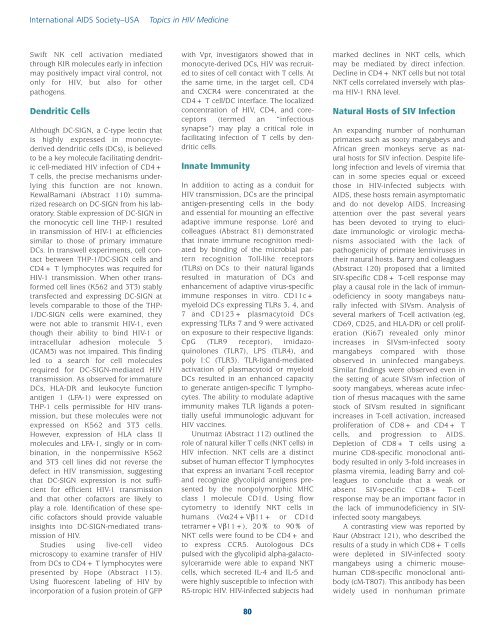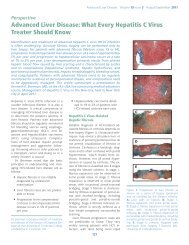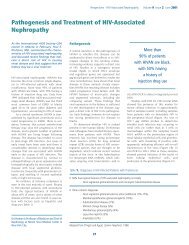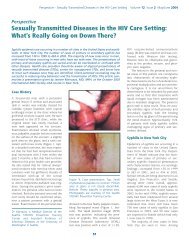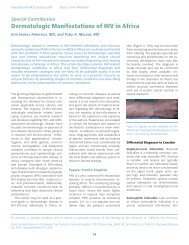Topics in HIV Medicine® - International AIDS Society-USA
Topics in HIV Medicine® - International AIDS Society-USA
Topics in HIV Medicine® - International AIDS Society-USA
Create successful ePaper yourself
Turn your PDF publications into a flip-book with our unique Google optimized e-Paper software.
<strong>International</strong> <strong>AIDS</strong> <strong>Society</strong>–<strong>USA</strong><br />
<strong>Topics</strong> <strong>in</strong> <strong>HIV</strong> Medic<strong>in</strong>e<br />
Swift NK cell activation mediated<br />
through KIR molecules early <strong>in</strong> <strong>in</strong>fection<br />
may positively impact viral control, not<br />
only for <strong>HIV</strong>, but also for other<br />
pathogens.<br />
Dendritic Cells<br />
Although DC-SIGN, a C-type lect<strong>in</strong> that<br />
is highly expressed <strong>in</strong> monocytederived<br />
dendritic cells (DCs), is believed<br />
to be a key molecule facilitat<strong>in</strong>g dendritic<br />
cell-mediated <strong>HIV</strong> <strong>in</strong>fection of CD4+<br />
T cells, the precise mechanisms underly<strong>in</strong>g<br />
this function are not known.<br />
KewalRamani (Abstract 110) summarized<br />
research on DC-SIGN from his laboratory.<br />
Stable expression of DC-SIGN <strong>in</strong><br />
the monocytic cell l<strong>in</strong>e THP-1 resulted<br />
<strong>in</strong> transmission of <strong>HIV</strong>-1 at efficiencies<br />
similar to those of primary immature<br />
DCs. In transwell experiments, cell contact<br />
between THP-1/DC-SIGN cells and<br />
CD4+ T lymphocytes was required for<br />
<strong>HIV</strong>-1 transmission. When other transformed<br />
cell l<strong>in</strong>es (K562 and 3T3) stably<br />
transfected and express<strong>in</strong>g DC-SIGN at<br />
levels comparable to those of the THP-<br />
1/DC-SIGN cells were exam<strong>in</strong>ed, they<br />
were not able to transmit <strong>HIV</strong>-1, even<br />
though their ability to b<strong>in</strong>d <strong>HIV</strong>-1 or<br />
<strong>in</strong>tracellular adhesion molecule 3<br />
(ICAM3) was not impaired. This f<strong>in</strong>d<strong>in</strong>g<br />
led to a search for cell molecules<br />
required for DC-SIGN-mediated <strong>HIV</strong><br />
transmission. As observed for immature<br />
DCs, HLA-DR and leukocyte function<br />
antigen 1 (LFA-1) were expressed on<br />
THP-1 cells permissible for <strong>HIV</strong> transmission,<br />
but these molecules were not<br />
expressed on K562 and 3T3 cells.<br />
However, expression of HLA class II<br />
molecules and LFA-1, s<strong>in</strong>gly or <strong>in</strong> comb<strong>in</strong>ation,<br />
<strong>in</strong> the nonpermissive K562<br />
and 3T3 cell l<strong>in</strong>es did not reverse the<br />
defect <strong>in</strong> <strong>HIV</strong> transmission, suggest<strong>in</strong>g<br />
that DC-SIGN expression is not sufficient<br />
for efficient <strong>HIV</strong>-1 transmission<br />
and that other cofactors are likely to<br />
play a role. Identification of these specific<br />
cofactors should provide valuable<br />
<strong>in</strong>sights <strong>in</strong>to DC-SIGN-mediated transmission<br />
of <strong>HIV</strong>.<br />
Studies us<strong>in</strong>g live-cell video<br />
microscopy to exam<strong>in</strong>e transfer of <strong>HIV</strong><br />
from DCs to CD4+ T lymphocytes were<br />
presented by Hope (Abstract 113).<br />
Us<strong>in</strong>g fluorescent label<strong>in</strong>g of <strong>HIV</strong> by<br />
<strong>in</strong>corporation of a fusion prote<strong>in</strong> of GFP<br />
with Vpr, <strong>in</strong>vestigators showed that <strong>in</strong><br />
monocyte-derived DCs, <strong>HIV</strong> was recruited<br />
to sites of cell contact with T cells. At<br />
the same time, <strong>in</strong> the target cell, CD4<br />
and CXCR4 were concentrated at the<br />
CD4+ T cell/DC <strong>in</strong>terface. The localized<br />
concentration of <strong>HIV</strong>, CD4, and coreceptors<br />
(termed an “<strong>in</strong>fectious<br />
synapse”) may play a critical role <strong>in</strong><br />
facilitat<strong>in</strong>g <strong>in</strong>fection of T cells by dendritic<br />
cells.<br />
Innate Immunity<br />
In addition to act<strong>in</strong>g as a conduit for<br />
<strong>HIV</strong> transmission, DCs are the pr<strong>in</strong>cipal<br />
antigen-present<strong>in</strong>g cells <strong>in</strong> the body<br />
and essential for mount<strong>in</strong>g an effective<br />
adaptive immune response. Loré and<br />
colleagues (Abstract 81) demonstrated<br />
that <strong>in</strong>nate immune recognition mediated<br />
by b<strong>in</strong>d<strong>in</strong>g of the microbial pattern<br />
recognition Toll-like receptors<br />
(TLRs) on DCs to their natural ligands<br />
resulted <strong>in</strong> maturation of DCs and<br />
enhancement of adaptive virus-specific<br />
immune responses <strong>in</strong> vitro. CD11c+<br />
myeloid DCs express<strong>in</strong>g TLRs 3, 4, and<br />
7 and CD123+ plasmacytoid DCs<br />
express<strong>in</strong>g TLRs 7 and 9 were activated<br />
on exposure to their respective ligands:<br />
CpG (TLR9 receptor), imidazoqu<strong>in</strong>olones<br />
(TLR7), LPS (TLR4), and<br />
poly I:C (TLR3). TLR-ligand-mediated<br />
activation of plasmacytoid or myeloid<br />
DCs resulted <strong>in</strong> an enhanced capacity<br />
to generate antigen-specific T lymphocytes.<br />
The ability to modulate adaptive<br />
immunity makes TLR ligands a potentially<br />
useful immunologic adjuvant for<br />
<strong>HIV</strong> vacc<strong>in</strong>es.<br />
Unutmaz (Abstract 112) outl<strong>in</strong>ed the<br />
role of natural killer T cells (NKT cells) <strong>in</strong><br />
<strong>HIV</strong> <strong>in</strong>fection. NKT cells are a dist<strong>in</strong>ct<br />
subset of human effector T lymphocytes<br />
that express an <strong>in</strong>variant T-cell receptor<br />
and recognize glycolipid antigens presented<br />
by the nonpolymorphic MHC<br />
class I molecule CD1d. Us<strong>in</strong>g flow<br />
cytometry to identify NKT cells <strong>in</strong><br />
humans (Vα24+Vβ11+ or CD1d<br />
tetramer+Vβ11+), 20% to 90% of<br />
NKT cells were found to be CD4+ and<br />
to express CCR5. Autologous DCs<br />
pulsed with the glycolipid alpha-galactosylceramide<br />
were able to expand NKT<br />
cells, which secreted IL-4 and IL-5 and<br />
were highly susceptible to <strong>in</strong>fection with<br />
R5-tropic <strong>HIV</strong>. <strong>HIV</strong>-<strong>in</strong>fected subjects had<br />
marked decl<strong>in</strong>es <strong>in</strong> NKT cells, which<br />
may be mediated by direct <strong>in</strong>fection.<br />
Decl<strong>in</strong>e <strong>in</strong> CD4+ NKT cells but not total<br />
NKT cells correlated <strong>in</strong>versely with plasma<br />
<strong>HIV</strong>-1 RNA level.<br />
Natural Hosts of SIV Infection<br />
An expand<strong>in</strong>g number of nonhuman<br />
primates such as sooty mangabeys and<br />
African green monkeys serve as natural<br />
hosts for SIV <strong>in</strong>fection. Despite lifelong<br />
<strong>in</strong>fection and levels of viremia that<br />
can <strong>in</strong> some species equal or exceed<br />
those <strong>in</strong> <strong>HIV</strong>-<strong>in</strong>fected subjects with<br />
<strong>AIDS</strong>, these hosts rema<strong>in</strong> asymptomatic<br />
and do not develop <strong>AIDS</strong>. Increas<strong>in</strong>g<br />
attention over the past several years<br />
has been devoted to try<strong>in</strong>g to elucidate<br />
immunologic or virologic mechanisms<br />
associated with the lack of<br />
pathogenicity of primate lentiviruses <strong>in</strong><br />
their natural hosts. Barry and colleagues<br />
(Abstract 120) proposed that a limited<br />
SIV-specific CD8+ T-cell response may<br />
play a causal role <strong>in</strong> the lack of immunodeficiency<br />
<strong>in</strong> sooty mangabeys naturally<br />
<strong>in</strong>fected with SIVsm. Analysis of<br />
several markers of T-cell activation (eg,<br />
CD69, CD25, and HLA-DR) or cell proliferation<br />
(Ki67) revealed only m<strong>in</strong>or<br />
<strong>in</strong>creases <strong>in</strong> SIVsm-<strong>in</strong>fected sooty<br />
mangabeys compared with those<br />
observed <strong>in</strong> un<strong>in</strong>fected mangabeys.<br />
Similar f<strong>in</strong>d<strong>in</strong>gs were observed even <strong>in</strong><br />
the sett<strong>in</strong>g of acute SIVsm <strong>in</strong>fection of<br />
sooty mangabeys, whereas acute <strong>in</strong>fection<br />
of rhesus macaques with the same<br />
stock of SIVsm resulted <strong>in</strong> significant<br />
<strong>in</strong>creases <strong>in</strong> T-cell activation, <strong>in</strong>creased<br />
proliferation of CD8+ and CD4+ T<br />
cells, and progression to <strong>AIDS</strong>.<br />
Depletion of CD8+ T cells us<strong>in</strong>g a<br />
mur<strong>in</strong>e CD8-specific monoclonal antibody<br />
resulted <strong>in</strong> only 3-fold <strong>in</strong>creases <strong>in</strong><br />
plasma viremia, lead<strong>in</strong>g Barry and colleagues<br />
to conclude that a weak or<br />
absent SIV-specific CD8+ T-cell<br />
response may be an important factor <strong>in</strong><br />
the lack of immunodeficiency <strong>in</strong> SIV<strong>in</strong>fected<br />
sooty mangabeys.<br />
A contrast<strong>in</strong>g view was reported by<br />
Kaur (Abstract 121), who described the<br />
results of a study <strong>in</strong> which CD8+ T cells<br />
were depleted <strong>in</strong> SIV-<strong>in</strong>fected sooty<br />
mangabeys us<strong>in</strong>g a chimeric mousehuman<br />
CD8-specific monoclonal antibody<br />
(cM-T807). This antibody has been<br />
widely used <strong>in</strong> nonhuman primate<br />
80


